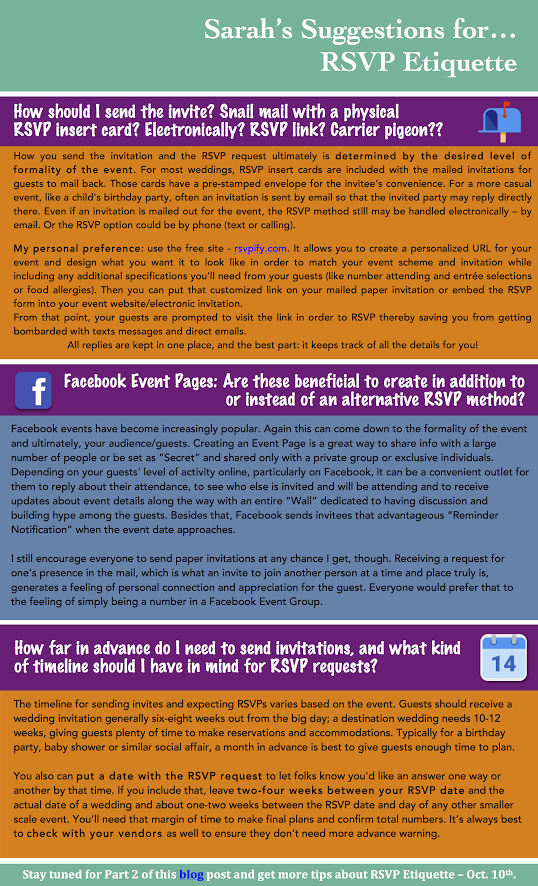My first blog post in the “Sarah’s Suggestions for… series” covered starting points for Party Planning and alluded to the importance of providing an easy and efficient way for guests to RSVP. This is such a vital aspect of event planning, I wanted to expound upon the etiquette behind the RSVP request.
*This will be split into two parts, so be sure you catch the second half when that’s published on Monday, Oct. 10th. We’ll start with basics in this post.
Here are some of my suggestions for FAQ, as well as some maybe Not-So-FAQ you’ve wondered to yourself, regarding invitations and corresponding RSVP requests…

- How should I send the invitation? Snail mail with a physical RSVP insert card? Electronically? RSVP link? Carrier pigeon??
How you send the invitations and the RSVP request ultimately is determined by the desired level of formality of the event. For most weddings, RSVP insert cards are included with the mailed invitations for guests to mail back. Those cards have a pre-stamped envelope for the invitee’s convenience. For a more casual event, like a child’s birthday party, often an invitation is sent by email so that the invited party may reply directly there. Even if an invitation is mailed out for the event, the RSVP method still may be handled electronically – by email. Or the RSVP option could be by phone (text or calling).
My personal preference: use the free site – rsvpify.com. It allows you to create a personalized URL for your event and design what you want it to look like in order to match your event scheme and invitation while including any additional specifications you’ll need from your guests (like number attending and entrée selections or food allergies). Then you can put that customized link on your mailed paper invitation or embed the RSVP form into your event website/electronic invitation.
From that point, your guests are prompted to visit the link in order to RSVP thereby saving you from getting bombarded with texts messages and direct emails.
All replies are kept in one place, and the best part: it keeps track of all the details for you!
- Facebook Event Pages: Are these beneficial to create in addition to or instead of an alternative RSVP method?
Facebook events have become increasingly popular. Again this can come down to the formality of the event and ultimately, your audience/guests. Creating an Event Page is a great way to share info with a large number of people or be set as “Secret” and shared only with a private group or exclusive individuals. Depending on your guests’ level of activity online, particularly on Facebook, it can be a convenient outlet for them to reply about their attendance, to see who else is invited and will be attending and to receive updates about event details along the way with an entire “Wall” dedicated to having discussion and building hype among the guests. Besides that, Facebook sends invitees that advantageous “Reminder Notification” when the event date approaches.
I still encourage everyone to send paper invitations at any chance I get, though. Receiving a request for one’s presence in the mail, which is what an invite to join another person at a time and place truly is, generates a feeling of personal connection and appreciation for the guest. Everyone would prefer that to the feeling of simply being a number in a Facebook Event Group.
- How far in advance do I need to send invitations, and what kind of timeline should I have in mind for the RSVP requests?
The timeline for sending invites and expecting RSVPs varies based on the event. Guests should receive a wedding invitation generally six-eight weeks out from the big day; a destination wedding needs 10-12 weeks, giving guests plenty of time to make reservations and accommodations. Typically for a birthday party, baby shower or similar social affair, a month in advance is best to give guests enough time to plan.
You also can put a date with the RSVP request to let folks know you’d like an answer one way or another by that time. If you include that, leave two-four weeks between your RSVP date and the actual date of a wedding and about one-two weeks between the RSVP date and day of any other smaller scale event. You’ll need that margin of time to make final plans and confirm total numbers. It’s always best to check with your vendors as well to ensure they don’t need more advance warning.

